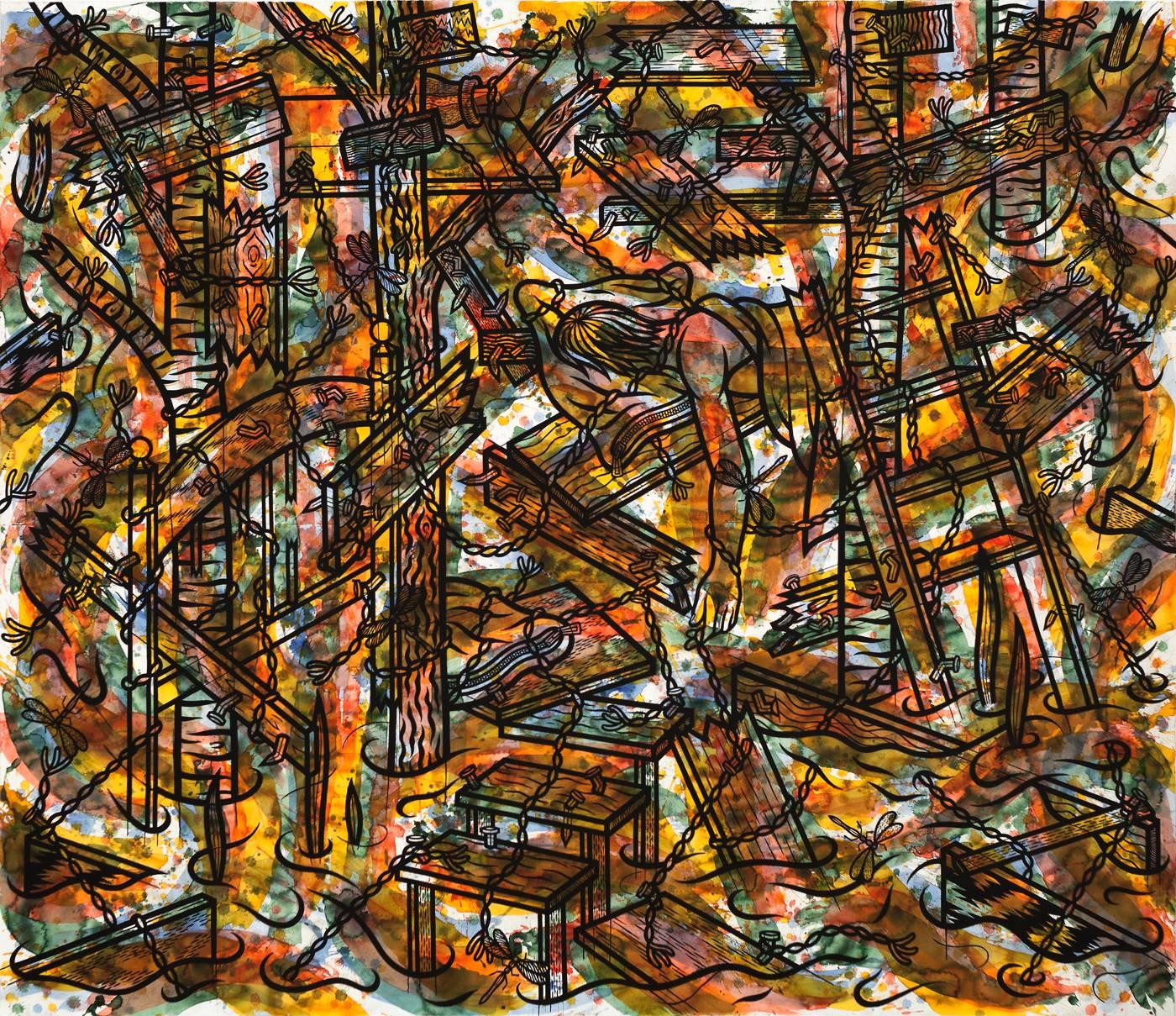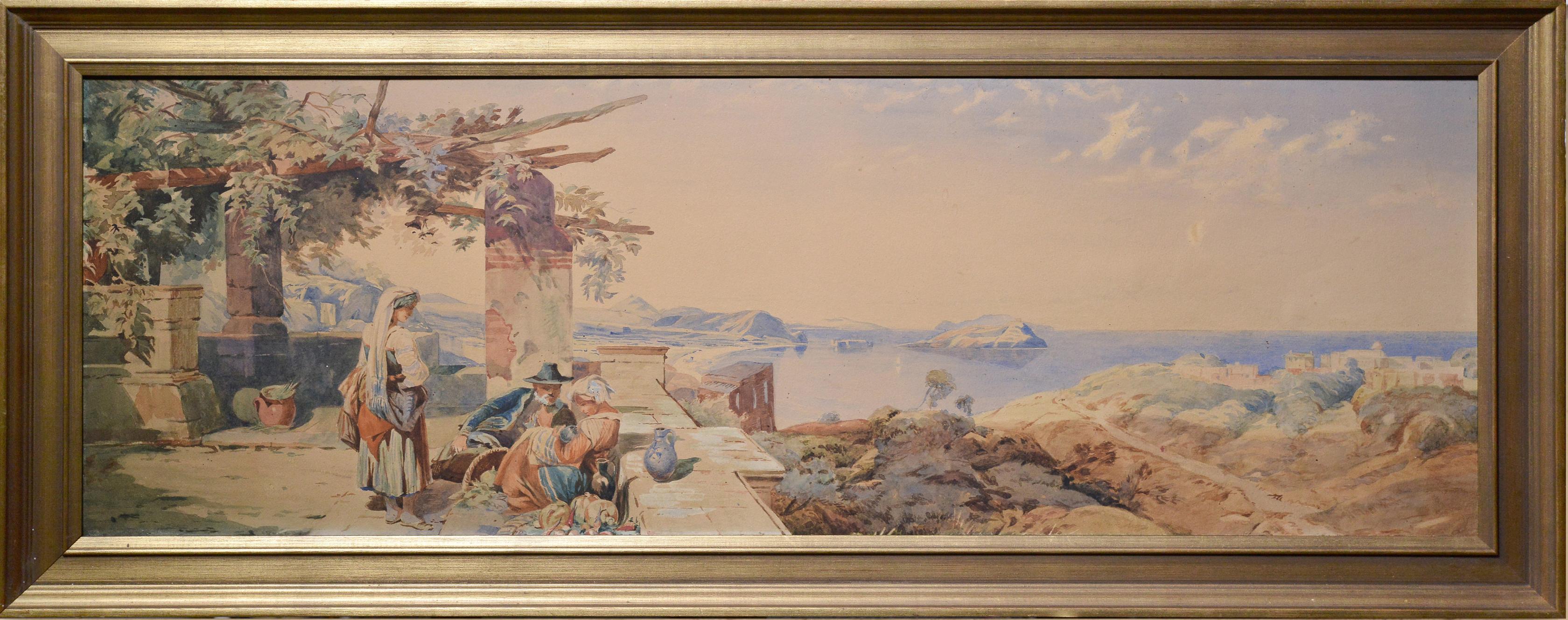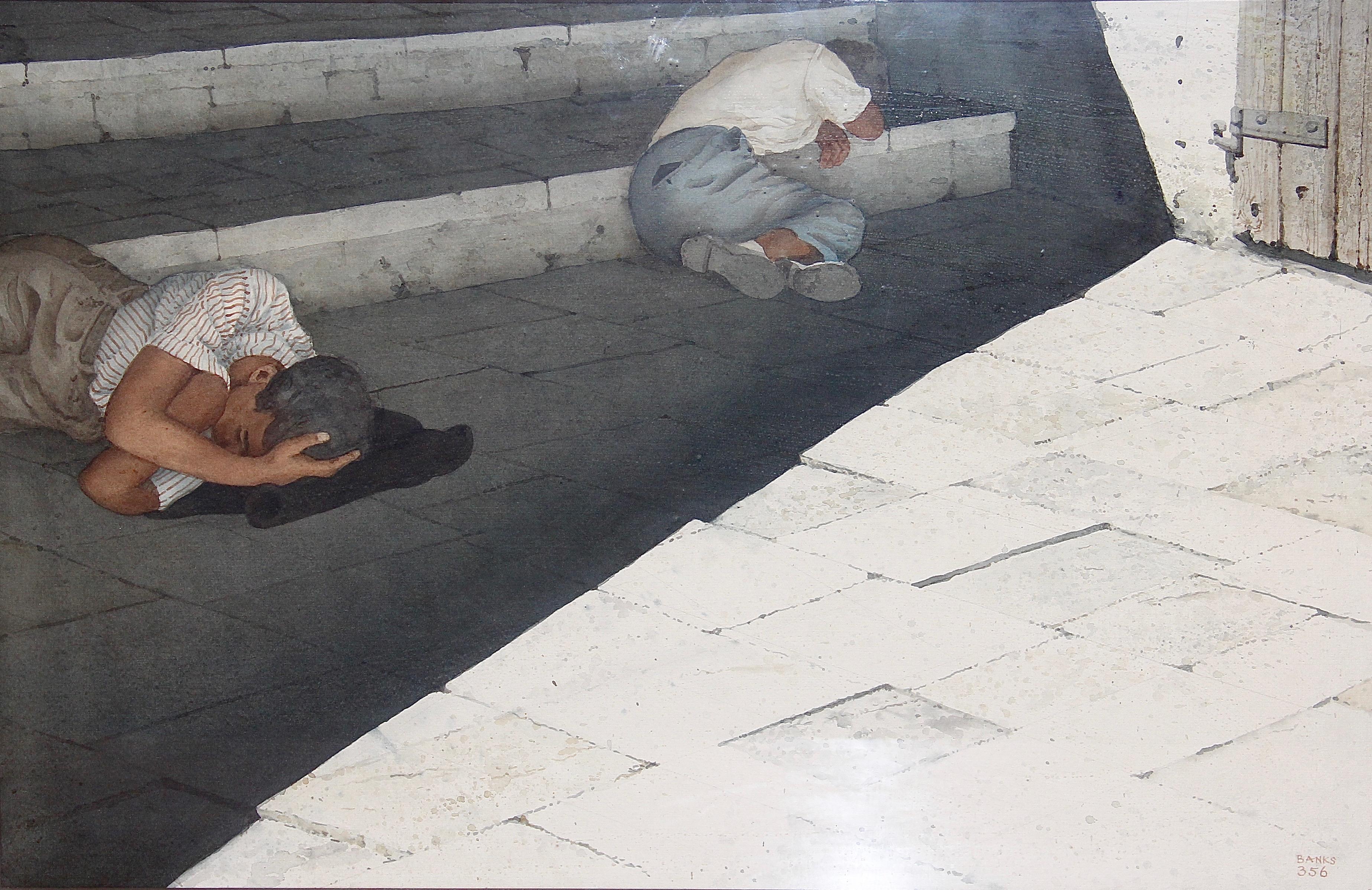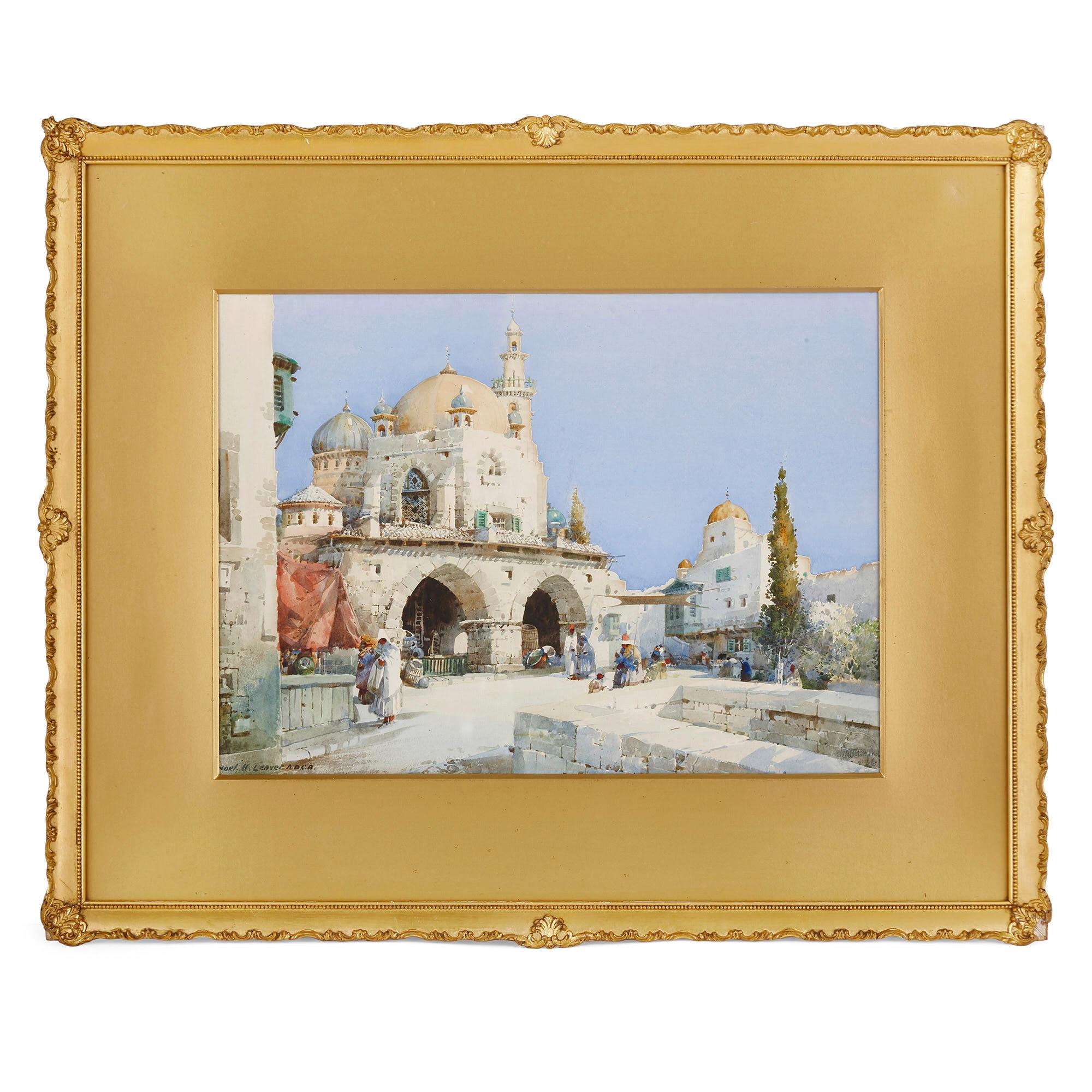Items Similar to "Amina and Sigmund" Double Portrait, Abstract Expressionist Female, Watercolor
Want more images or videos?
Request additional images or videos from the seller
1 of 5
Grace Hartigan"Amina and Sigmund" Double Portrait, Abstract Expressionist Female, Watercolor1986
1986
About the Item
Grace Hartigan
Amina and Sigmund, 1986
Signed and dated lower right
Watercolor on paper
84 x 60 inches
Grace Hartigan’s career began among the New York School artists of the 1940s and 1950s after she left her birthplace of Newark, NJ where she studied mechanical drafting as well as painting under Isaac Lane Muse. She befriended and was accepted among established Abstract Expressionists such as Jackson Pollock, Willem de Kooning, Larry Rivers, and poet Frank O’Hara. While she subscribed to the popular mode of painterly expression and the visibility of the artist’s hand, her work extends beyond the individual. Her later works employ both popular culture and art historical references (Hartigan made a conscious decision in 1952 to paint studies after the Old Masters) in a way that helped her paintings resonate with contemporary American life, particularly that of her own locale in the East Village. For Hartigan, abstraction and figuration were not mutually exclusive; pictorial structures in her work are vehicles for emotion, and are handled in a painterly, expressionist manner.
It is for her bold stylistic experimentation that Hartigan is best known. Her brushstrokes are gestural, exude a sense of urgency, and create dramatic lines filled with washes of opulent color, culminating in lyric compositions that dance across the surface of the canvas. Her works from the 1960s take an organic, curvilinear form, while later works from the 1970s are distinctly more figural, showcasing a collection of invented symbols reflecting her interest in mythological subjects.
During the 1950s the Tibor de Nagy Gallery, a spot known as a salon of sorts for the New York School, hosted seven solo exhibitions of Hartigan’s work. She was selected in 1950 for the New Talent exhibition organized by influential critics Clement Greenberg and Meyer Schapiro at another prominent mid-century gallery, the Samuel Kootz Gallery. She was the only woman artist included in The Museum of Modern Art’s international exhibition The New American Painting, which traveled from New York City across Europe between 1958 and 1959. Her paintings and biography were additionally featured in Life magazine and Newsweek at the end of the decade.
A rejection of Abstract Expressionism and the subsequent shift in favor toward Pop and Minimalist styles during the 1960s motivated Hartigan to seek out what she considered to be a less creatively limiting environment. She relocated to Baltimore, Maryland where her career only continued to thrive. She was appointed Director of the Graduate Hoffberger School of Painting at the Maryland Institute College of Art, and gained representation by the C. Grimaldis Gallery, which remains her primary representation after her death in 2008. Six colleges and universities across Maryland and Pennsylvania selected Hartigan to receive honorary degrees. She is also the recipient of numerous additional awards and honors including the Lifetime Achievement Award (Neuberger Museum, 2002) and the Governor’s Award (Baltimore, MA 2006).
Hartigan’s legacy is significant not only in her contribution to the development of American painting, but also as an example of a strong and independent female influence on the mid-century New York art scene. Her career allows art historians today the opportunity to reconsider a generation and artistic era often defined in narrow, patriarchal terms. Her talent did not go unrecognized despite the overwhelming attention given to her male contemporaries. She was able to embrace and contribute to the evolution of Abstract Expressionism while also maintaining a sense of what distinguished her oeuvre, ultimately positioning it to remain relevant in the latter decades of the twentieth century. Her re-introduction of figurative representation, interpreted in a painterly manner rather than necessarily striving for an antiquated sense of realism, paved the way for the New Figuration and Neo-Expressionist artists of the 1970s and 1980s.
- Creator:Grace Hartigan (1922-2008, American)
- Creation Year:1986
- Dimensions:Height: 87 in (220.98 cm)Width: 63 in (160.02 cm)
- More Editions & Sizes:Unique workPrice: $45,000
- Medium:
- Period:
- Framing:Framing Options Available
- Condition:
- Gallery Location:New York, NY
- Reference Number:1stDibs: LU1841214454492
About the Seller
5.0
Platinum Seller
These expertly vetted sellers are 1stDibs' most experienced sellers and are rated highest by our customers.
Established in 2021
1stDibs seller since 2022
63 sales on 1stDibs
Typical response time: <1 hour
- ShippingRetrieving quote...Ships From: New York, NY
- Return PolicyA return for this item may be initiated within 3 days of delivery.
More From This SellerView All
- "In Foreign Parts" Eugene Higgins, Southwestern Pueblo, Modern FigurativeBy Eugene HigginsLocated in New York, NYEugene Higgins In Foreign Parts, circa 1913 Signed lower right Watercolor on paper Sight 17 x 13 inches Born William Victor Higgins in 1884 to a Shelbyville, Indiana farm family where the only art Victor was aware of as a child was his father's love of flowers. "He loved their forms and their colors, and he tended his garden as a painter might work a canvas." At the age of nine, Victor met a young artist who traveled the Indiana countryside painting advertisements on the sides of barns. He purchased paints and brushes so the young Higgins could practice his own artwork on the inside of his father's barn. He also taught Victor about art museums and especially about the new Chicago Art Institute. This information never left the young artist, and he saved his allowance until his father allowed him at the age of fifteen to attend Chicago Art Institute. He worked a variety of jobs to finance his studies both there and at the Academy of Fine Arts. Victor Higgins traveled to New York in 1908, where he met Robert Henri, who became a significant influence by depicting every-day scenes and stressing the importance of the spirit and sense of place as important factors in painting. Higgins was also greatly affected by the New York Armory Modernism Show of Marsden Hartley in 1913. While Victor Higgins was in Chicago he met former mayor and avid collector Carter H. Harrison who was to prove instrumental in the growth of Higgins career for several years. Harrison agreed to support Higgins for four years to go to Paris and Munich and paint and study in the great museums in Europe. While at the Academie de la Grande Chaumier in Paris (1910-1914) he met Walter Ufer, who was another Chicago artist being sponsored by Carter Harrison. This meeting was not only a life-long friendship, but the beginning of a great change in the way Higgins looked at "American" art. He decided that America needed it's own authentic style rather than the 19th Century classic style he was taught in Europe. Very soon after returning to Chicago in 1914, Harrison sent him and Walter Ufer on a painting trip to Taos, New Mexico for a year in exchange for paintings. Higgins made other similar agreements and was able to support himself with his painting. This trip was a life-changing experience and introduced Higgins to the authentic America he had been looking for. In 1914 Taos was an isolated village about twelve hours from Santa Fe on an impossible dirt road. But the colorful life of the pueblo people and the natural beauty drew a collection of artists who became the Taos art colony, from which the Taos Society of Artists was founded in 1915. Victor Higgins became a permanent resident within a year of his arrival and a member of the society in 1917, exhibiting with Jane Peterson in 1925 and with Wayman Adams and Janet Scudder in 1927. The members would travel around the country introducing the Southwest scenes with great success. He remained a member until the Society's dissolution in 1927. Higgins was the youngest member of the group of seven. Other members were Joseph Henry Sharp, Bert Phillips...Category
1910s American Modern Figurative Drawings and Watercolors
MaterialsWatercolor, Paper
- "Zapotecan" Marion Greenwood, Indigenous Mexican Figurative WatercolorBy Marion GreenwoodLocated in New York, NYMarion Greenwood Zapotecan, 1956 Signed and dated Watercolor on paper 12 1/4 x 9 5/8 inches Provenance: Milch Galleries, New York Marion Greenwood, a painter and printmaker, was bo...Category
1950s Figurative Drawings and Watercolors
MaterialsPaper, Watercolor
- "Portrait of an Italian Fencer, " John Frederick Kensett, Hudson River SchoolBy John Frederick KensettLocated in New York, NYJohn Frederick Kensett (1816 - 1872) Portrait of an Italian Fencer, circa 1845-47 Watercolor on wove paper 13 1/8 x 8 1/8 inches Signed with initials and inscribed lower right "J.F.K. Rome" From October 1845 through the spring of 1847, Kensett lived in Rome. He attended classes where he sketched from live models, and he sketched in the countryside outside Rome and around Florence, Perugia, and Venice, places he visited with his artist friends. He fulfilled commissions for paintings from Americans in Italy, and by 1847 his career was well established. Son of an English immigrant engraver, John Kensett lacked enthusiasm for that medium and became one of the most accomplished painters of the second generation of Hudson River School painters. His reputation is for Luminism, careful depiction of light, weather, and atmosphere as they affect color and texture of natural forms. He was particularly influenced by the painting of Asher Durand in that he focused on realism and detail rather than the highly dramatic views associated with Thomas Cole. Going to the western United States in the mid 1850s and the 1860s, he was the first of the Hudson River School painters to explore and paint the West. Kensett was born and raised in Cheshire, Connecticut, and learned his engraving from his father, Thomas Kensett with whom he worked in New Haven, Connecticut until 1829. He continued working until 1840 as an engraver of labels, banknotes and maps and was employed part of that time by the American Bank Note Company in New York City. There he met Thomas Rossiter, John Casilear, and other artists who urged him to pursue painting. In 1840, he and Rossiter, Asher Durand, and Casilear went to Europe where Kensett stayed for seven years and supported himself by doing engraving but became accomplished in landscape painting. Having sent canvases of Italian landscapes back to New York, he had a reputation for skillful painting that preceded him. When he returned to New York City in 1847, he was an "instant success" and very sought after by collectors. Two of his Italian landscapes had already been purchased by the American Art Union. By 1849, he was a full member of the National Academy of Design and was generally popular among his peers. His studio was a gathering place with travelers stopping by to see his canvases and to identify "precise locations in the Catskills or Newport or New England in the oil sketches and drawings that covered his walls." (Zellman 170). For the women, he was a popular bachelor, "romantic looking with high forehead and sensitive expression." (Samuels 262) He was also sought after by many organizations. Among his activities were serving on the committee to oversee the decoration of the United States Capitol in Washington DC, and becoming one of the founders of the Metropolitan Museum in New York. An inveterate traveler, Kensett spent summers on painting excursions away from New York City. One of these trips was a special painting excursion with fifteen other artists sponsored by the B & O Railroad from Baltimore, Maryland to Wheeling, West Virginia. Unlike many of the Hudson River painters...Category
1840s Hudson River School Figurative Paintings
MaterialsWatercolor, Paper
- "Untitled" Bob Thompson, Figurative Work on Paper, Black Abstract ArtistBy Bob ThompsonLocated in New York, NYBob Thompson Untitled, 1964 Felt tip pen on printed paper 11 x 20 1/2 inches Provenance: The artist Kathy Komaroff Goodman (gift from the artist) Hollis Taggart, New York Exhibited...Category
1960s Modern Figurative Drawings and Watercolors
MaterialsWatercolor, Paper
- "Teenagers, Coney Island" Outdoor Scene, Figures in Landscape, Beach, New YorkBy Philip ReismanLocated in New York, NYPhilip Reisman Teenagers, Coney Island Signed lower left Watercolor on paper 12 3/4 x 10 3/4 inches When he was four years old, Reisman fled Polish pogroms with his mother and thre...Category
20th Century Realist Figurative Paintings
MaterialsPaper, Watercolor
- "Pleased to See You, " Crash, Pop Art, Street Art GraffitiBy John Crash MatosLocated in New York, NYCrash Pleased to See You, 1989 Signed and dated lower left Watercolor and ink on paper 30 x 20 1/2 inches A contemporary of Keith Haring and a modern-day master of this present day ...Category
1980s Street Art Figurative Paintings
MaterialsInk, Watercolor, Paper
You May Also Like
- RestBy Jesse LambertLocated in New York, NYink and watercolor on paper, 82" x96" This painting is from a new series of works by Jesse Lambert which ink and depict ad-hoc structures that are constructed out of scraps of woo...Category
2010s Contemporary Abstract Paintings
MaterialsArchival Paper, Watercolor, Archival Ink
- Panoramic View over Naples Bay 19th century Watercolor by Richardson RWSBy Thomas Miles Richardson IILocated in Stockholm, SEUnsigned, but it is attributed to Thomas Miles Richardson Jr., R.W.S. (1813 - 1890), since the similar work was sold through Christies in 1998 (same size with signature and date 1861...Category
Late 19th Century Realist Landscape Paintings
MaterialsWood, Paper, Watercolor, Cardboard
- Un Amour Rouge et BleuBy Sylvain LegrandLocated in Brecon, PowysSylvain a well regarded and established artist was born in 1953 in France. He has a representational style tinged with realism combining sensualism, mysticism and a natural harmony of colours. He established an art school in the South of France which was unfortunately destroyed by fire in 1983. In 1984 Sylvain won the Grand Prix of Societé des Bains de Mer (SBM) Art Gouache paint on Canson paper painted 26 April 1999 Size of Picture 70 cm x 42 cm Size of Frame (Intl decorated pallet wood...Category
Early 2000s Contemporary Figurative Paintings
MaterialsHandmade Paper, Gouache
- "Siesta in Ruvo - Apulia" 1969 Italy, works on paperBy Robert BanksLocated in Berlin, DERobert Banks "Siesta in Ruvo - Apulia" 1969 Italy. Behind glass. Property of Mrs. Pit. Masur. Measurements with Frame.Category
20th Century Impressionist Figurative Paintings
MaterialsWatercolor, Paper
- Orientalist view of a mosque by LeaverBy Noel Harry Leaver 1Located in London, GBThis watercolour on paper painting, by the English artist Noel Harry Leaver, depicts a distinctly Middle Eastern or North African urban setting, dominated by a domed mosque. To the ...Category
Early 20th Century Landscape Paintings
MaterialsWatercolor, Paper
- Set of six fairytale themed watercolours by German artist Otto KubelLocated in London, GBSet of six fairytale themed watercolours by German artist Otto Kubel German, early 20th Century Height 56cm, width 37cm These six works, by the celebrated German artist Otto Kubel, ...Category
Early 20th Century Figurative Paintings
MaterialsWatercolor, Paper
Recently Viewed
View AllMore Ways To Browse
Lyric Art
De Kooning Style
Meyers Museum
Vintage Vehicles
Baltimore Painters
Dancing Muses
Male Dancer Painting
84 Inch Painting
Mid Century Modern Paintings Male
Old Master Male
1950 Lane
1970s Drafting
Minimalist Modern Painting 1960s
Mid Century Modern Minimalist Painting Art
Tibor De Nagy
1959 Lane
Samuel Lines
Manner De Kooning





